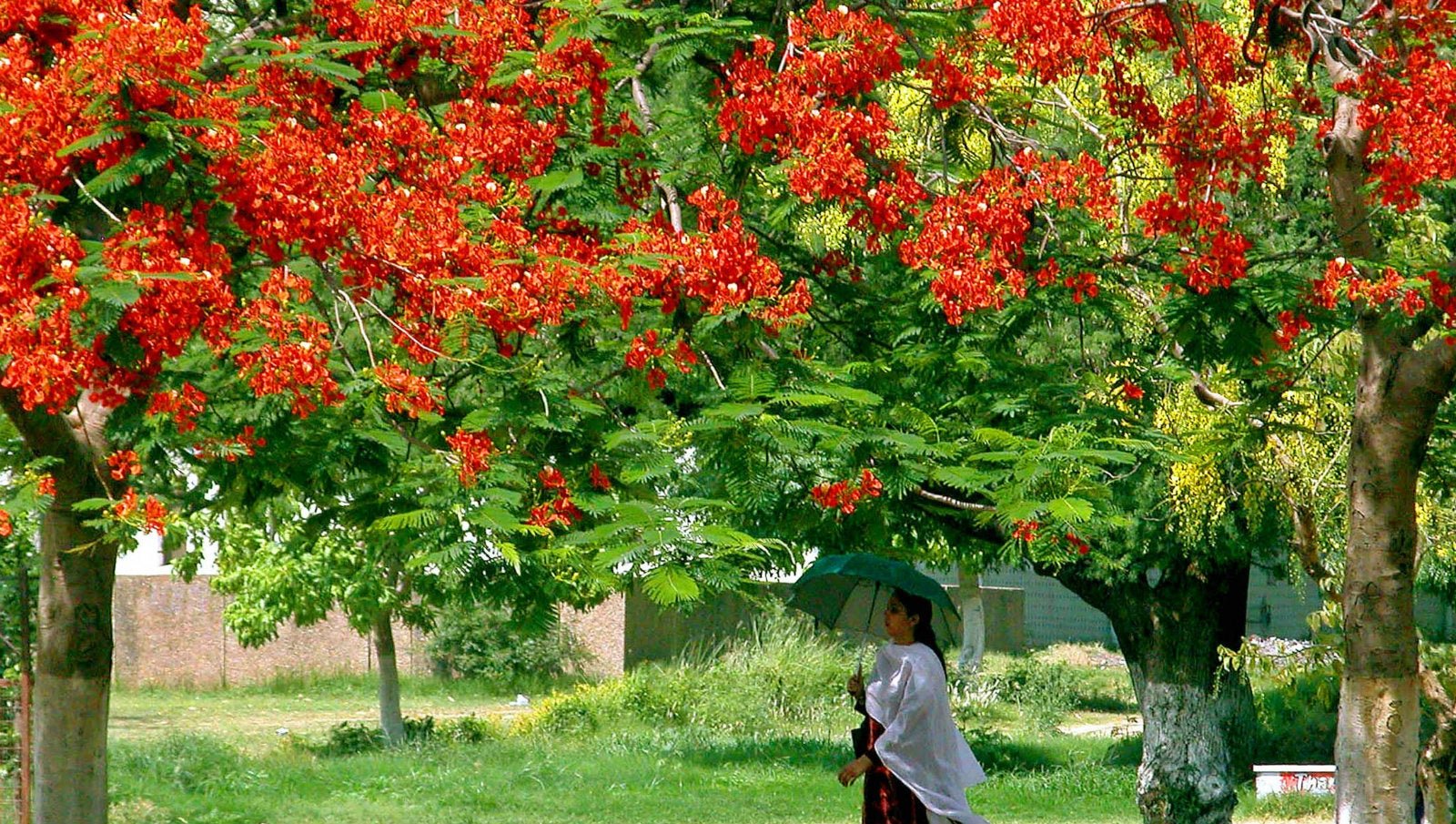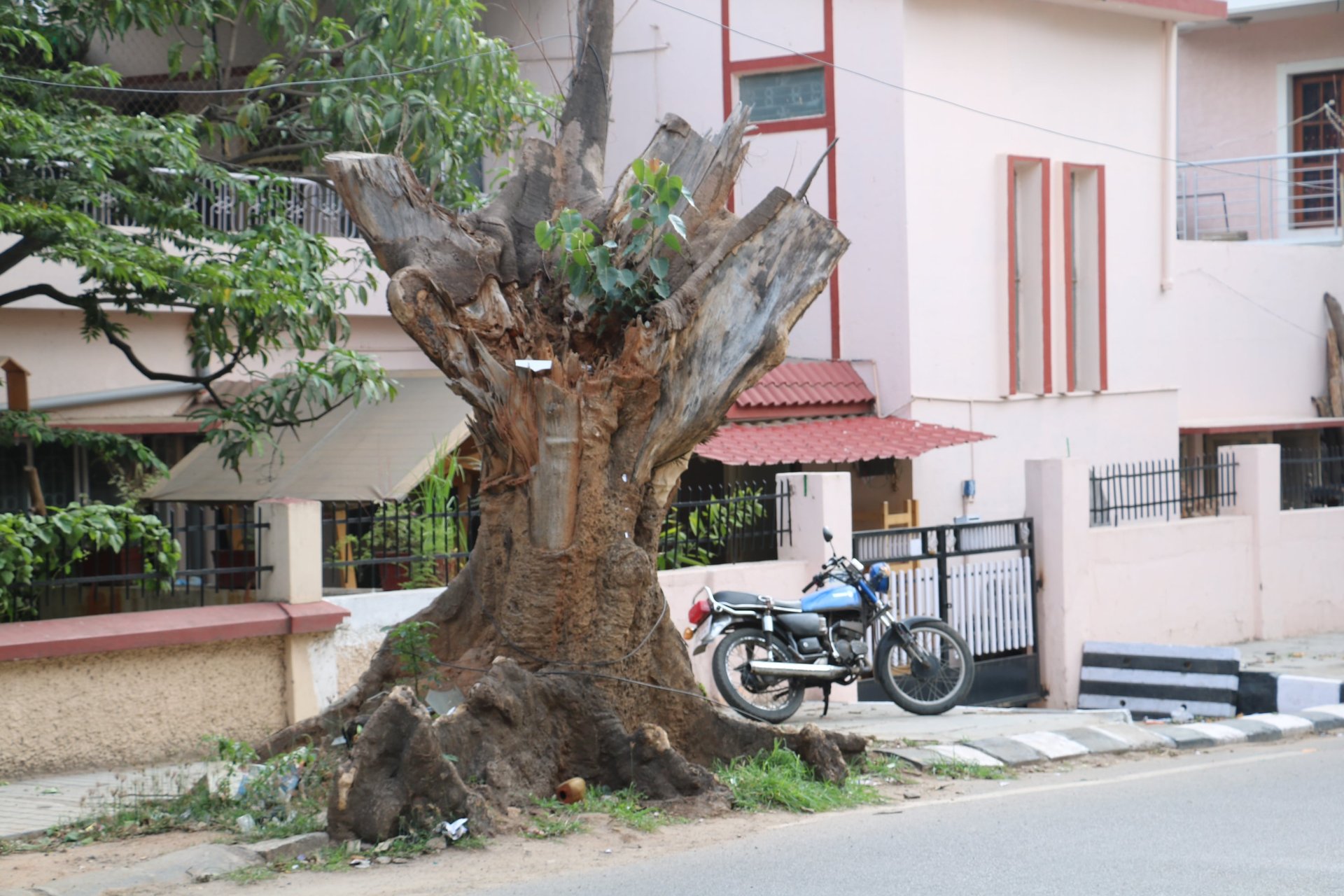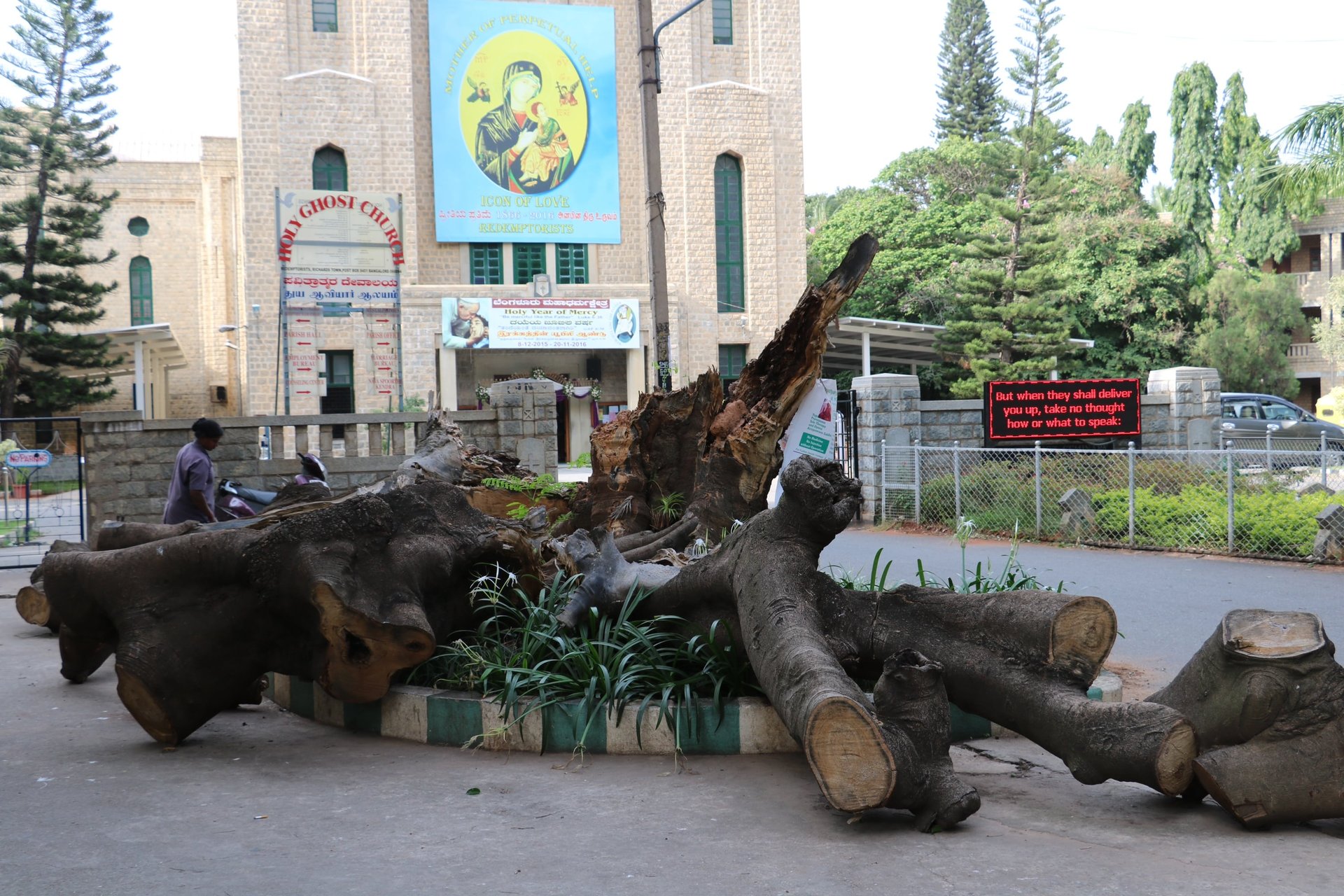In India’s Silicon Valley, dying trees mirror a beautiful city’s dreadful decline
During my morning run recently, I felt a great sadness as I paused at a 10-foot-high stump of a tree I once knew well. You see, this is the season for Bengaluru’s gulmohars—or mayflower trees—to bloom and lay a flame-orange carpet of flowers. That is what the magnificent, old specimen on the corner of Davis Road and Charles Campbell Road would have, had it been allowed to live.


During my morning run recently, I felt a great sadness as I paused at a 10-foot-high stump of a tree I once knew well. You see, this is the season for Bengaluru’s gulmohars—or mayflower trees—to bloom and lay a flame-orange carpet of flowers. That is what the magnificent, old specimen on the corner of Davis Road and Charles Campbell Road would have, had it been allowed to live.
I reckon it was about 80 years old, planted sometime after Richards Town in the central part of the city was laid down by colonial administrators, after whom the streets and neighbourhood are still named. It was a rare gulmohar, about four storeys high and matching in height those giants, the rain trees. Its canopy spread across the crossroad, shading the roads and the footpaths. The boys doing wheelies on motorcycles wobbled past it, nuns drifting by often picked up its flowers, old people leaned on it for support and I was happy to simply revel in its presence, ignoring the tangle of cable wires in its canopy.
Yet, these wires proved to be the grand gulmohar’s undoing. I had seen muttering servicemen stare at the entangled—and illegal —cable wires. One day, after returning from a work trip, I found that the tree, sentinel to eras, was gone. The wires are unhindered, and the street corner is desolate. Every month, the desolate spots multiply.
Last week, when I had returned from another trip, two more gulmohars I knew well were gone—one from the doorstep of the Holy Ghost Church, another a few metres away. They were smaller, but as colourful. Thousands of parishioners must have seen them chopped down. The trunks, chopped into pieces, still lie there. No one appears to notice, or care.


A tale of neglect
This is the story across Richards Town, Bengaluru and India’s great, exploding cities, which are likely to host about 300 million more people over the next 14 years. As a 2010 report from McKinsey said: “70% to 80% of India of 2030 is yet to be built.”
To deal with this urban explosion, the government is currently inviting applications to finance 100 smart cities that can provide for “the aspiration and needs of citizens”.
Some citizens—largely, those committed to saving what’s left, such as this vibrant group, Save the Bangalore Trees, on Facebook —are indeed concerned that the tide of economic growth and unprecedented opportunity is sweeping away thousands of trees, the very things that can fulfil their aspirations for a better life and mitigate the potentially catastrophic side effects of rising prosperity and a warming planet.
For every Bangalorean, there is now 0.1 tree, or a tenth of a tree. There should be 10 times that number if the city has to absorb the growing volumes of carbon dioxide from the 1,600 vehicles registered every day. “Since wide roads are being felled of trees across the city for road widening, this implies that Bangalore’s street tree population is being selectively denuded of its largest trees,” wrote Harini Nagendra, a professor at the Azim Premji University, in this 2010 study. In the years since Nagendra’s study, more than 50,000 trees have been lost, with only a few of the old gulmohars standing.
A wider problem
The dying of the gulmohars is a metaphor for unfolding urban disrepair and disarray. Its last rites were announced in 2014 when the city’s chief conservator of forests declared there was no place for the gulmohar, the rain tree and other avenue trees that gave Bengaluru its now-dead moniker of India’s garden city. “The large trees with deep roots damage sewage lines, boundary walls, sumps and not to talk of traffic blocks caused by fallen branches [sic],” Brijesh Kumar, the official guardian of trees, told The Times of India. “The roads get choked and traffic blocked.”
Kumar was right, except that despite thousands of trees cut, the roads are more choked than ever. The trees fall because they are constricted, imbalanced when their roots are hacked, or their branches are cut when builders add (often illegal) floors or when setbacks—the space between buildings and walls—are ignored. I have seen gulmohars being cut down simply to add a parking space or to stop the birds from dirtying cars.
Gulmohars, like rain trees, colonise the ground and air above them, making them particularly irksome to a city that has given itself the freedom to do as it pleases with a particular vengeance since it took on the mantle of India’s second-fastest growing city in the 1990s (Delhi is the fastest, but that city’s core has retained much of its greenery).
Price to pay
From the year I began college—1982—to 2012, Bengaluru lost 66% of its trees and 74% of its once-shimmering lakes, according to TV Ramachandra, the man who has statistically chronicled this decline. A professor at the Indian Institute of Science, Ramachandra, with his research group, found that over the same period, the area covered by buildings increased 584%.
It is a datum I quote often, as is the fact that Bengaluru experienced a summer of unprecedented temperatures in 2016. To be sure, the city’s average annual temperature rise was the same as the warming earth’s (0.9°C), but climate change isn’t to blame. In growing swathes of Bangalore, temperatures have increased by more than 2°C because the trees, lakes and open spaces are gone, replaced by buildings and roads that soak in and trap heat.
Country-wide problem
Bengaluru may be India’s most drastic example, but the short-sighted assault on greenery is nationwide. Making projections after comparing satellite images over decades, Ramachandra and his team also tell us that in 2030, Kolkata’s vegetation will cover just 3.37% of its area (from 34% in 1980) and Ahmedabad’s 3% (from 37% in 1990). By 2018, Bhopal’s trees will cover 11% of its area (from 67% in 1992) and Bengaluru’s 14% by 2020 (from 46% in 1992).
The de-greening of India’s cities is creating water-starved heat islands, a slew of studies over the last two years indicate.
In this era of smart-city chatter, the pressures on urban India will be outsized. In the decade starting 2000, India witnessed its greatest surge in urban population at 26%—another datum I have used before. That is mild compared to what’s coming. India’s urban population growth rate will be 62% between 2010 and 2020 and 108% between 2020 and 2030, according to United Nations population projections.
Destruction without a cause
The most disturbing part of the dying of gulmohars is that, despite the population and construction explosion, they don’t need to. Trees can remain a part of our cities as they go upward, lay down roads and built metro railways. But since Indian cities are governed not by mayors but by chief ministers—in Delhi’s case, the chief minister is really no more than a mayor—with few political stakes and a plethora of bureaucrats largely unanswerable to the public, there is no place for experts.
This was made amply clear in a series of stories in the Bangalore Mirror, recently, which said that India’s science city was “done in by poor science” and the “vain arrogance on the part of the civic agencies”, who “blatantly” ignored scientific advice and data pouring out of Bangalore’s diverse scientific institutions.
One of those experts is Ramachandra, who now predicts that 93% of the city will be paved over in the next six years, making it poor in water but rich in greenhouse gases that warm it up and deprive its people of clean air and water. The city has ignored Ramachandra’s plans to rejuvenate its lakes. It has ignored an offer from its only Institute of Wood Science and Technology to help study and shore up the remaining avenue trees, especially vulnerable rain trees and gulmohars, the Bangalore Mirror reported.
Instead, the municipal corporation’s officials have no plans to continue a storied tradition of planning and planting avenues with trees, started in the 1920s by Gustav Krumbiegel, a German botanist hired by the Maharaja of Mysore, and continued by the inheritors of his legacy into the 1980s. The tree in favour in modern times is the royal palm, sterile to birds and bereft of shade-giving canopy.
“Can Bengaluru [the city’s new name] survive?” the Bangalore Mirror asked. The old Bangalore is dead. The new Bengaluru and urban India will survive, of course, but as a hapless, haphazard and treeless conglomeration of densely packed lower and middle-class ghettoes, the rich sequestered—as they already are—in gated communities.
Rapid decline
That process is gathering pace in my neighbourhood. As the bungalows went down—it is foolish to expect them to stand forever—the first multi-storied constructions adhered to setbacks. That allowed many trees to be retained and breathing space between buildings. Today, the setback laws are ignored, and quiet tree-lined lanes of creeper-and flower-decked homes have become treeless, concrete, air-conditioned ghettos—artificially created heat islands in a city that once did not need even ceiling fans.
There were no fans in the old, stone house we moved into when I first came to Bangalore in 1969. Every avenue was a shaded tunnel of rain trees and other towering, flowering species, each laying down their distinctive carpets of yellow, purple and red— the copperpod, the laburnum, the gulmohar, the jacaranda—when their time to bloom came.
Where once the eye surveyed an ocean of green from the air, there are now only patches, thanks largely to the Army, the church and older academic institutions, custodians of the last trees. There are still a few avenues with rain-tree tunnels and gulmohars, but it is hard to shake the feeling that their end of days is at hand.
When we talked of moving back to Bengaluru from Delhi five years ago, my wife had one condition: Don’t talk about the past, don’t go on about how there were beautiful bungalows on this road, trees on that road.
But she did agree that we should find a flat that at least gave us the illusion of the old Bangalore. It must have trees, we told our estate agent. After we rejected more than 20 houses, he gathered us up one fine day and charged into what is now our home. “Dekho bhaijaan [look, brother],” he said in the local Dakhini language. “Ek jhaad idhaar, ek udhaar, aur ketta jhaad hona tumna?” A tree here, a tree there, how many more do you want?
Indeed, two floors up, sprawling rain trees on the streets outside shade most of our windows. Our living room patio is framed against the rich, pink blossoms of a now-rare Tabebuia rosea, a rosy trumpet tree in the compound of the house in front of us.
“You know, that rosea will go sometime, when that house goes down,” I told my wife on one windswept, cool evening (we still have those, eight months of the year). Around us, a house seems to go down every month, sometimes two, as the concrete ghettos ring-fence us.
“I know,” she said.
And then what? I asked.
She pointed to our rain trees. “When they go,” she said, “So will we.”
This post first appeared on Scroll.in.
We welcome your comments at [email protected].